From Puddles to Pigeons: Learning about Nature in Cities
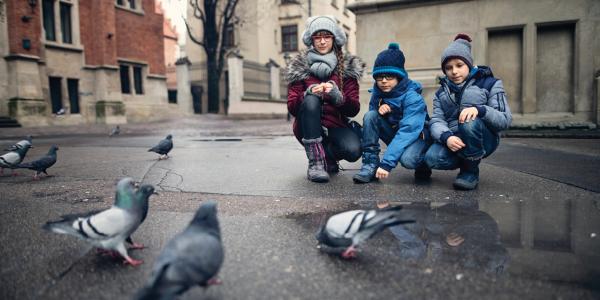
You are here
Sofia, a busy mother, looks out the window and notices that it has stopped raining. She pulls out a family science activity about rain that she received at her local community center and quickly reads through the step-by-step instructions. Within minutes, she and Andre, her 7-year-old son, pull on their rain boots, grab a piece of chalk, and head outside. Puddles are scattered along their block, and Andre jumps in several to compare how many jumps it takes to empty them.
“Look at these two puddles,” says Sofia, pointing to one in the middle of the sunny sidewalk and another in the shade of their building. “Which do you think will disappear first?” Andre thinks, then points to the first puddle. “Why?” she asks, and he predicts that more people will walk through that puddle and that the sun will help it dry up faster. “Let’s see if you’re right,” suggests Sofia. Andre uses the chalk to outline both puddles.
The next day, they check the puddles—once on their morning walk to the bus stop and again after school. Each time, Andre draws increasingly smaller puddle outlines until the puddle in the middle of the sidewalk is gone entirely. “We were right!” says Andre. He and his mother plan future investigations to continue exploring water in their neighborhood.
The outdoors is a great place to learn about science. Children can develop their understanding of evaporation and water flow by exploring puddles and drains, investigate animal behaviors by observing birds and bugs, and learn about life cycles by watching plants sprout, grow, flower, and create seeds. But many children who live in urban areas miss out on the rich and varied opportunities for science learning afforded by the outdoors.
Parents, educators, and other primary caregivers might not realize that a small patch of grass, a single tree, and a walk to the store are opportunities to observe nature, generate questions, and conduct experiments to find answers—all critical science practices. Taking advantage of these opportunities provides children with ways to engage with important environmental science concepts, connect science with the real world, and build their understandings of everyday phenomena, such as why leaves fall from trees, where rain goes in a city, and how city animals find shelter.
A prescription for science exploration and family fun in the city
Unfortunately, families in urban settings often view the outdoors not as a rich environment for exploration, but merely as a place for children to play or as an uninteresting space between one building and another (Aaron & Witt 2011). This is especially the case in low-income, metropolitan neighborhoods where open, well-maintained green spaces are rare. Many urban families do not think nature exists in urban settings, don’t think of urban areas as places where they can do nature-based activities, or don’t think there’s a meaningful way to interact with nature in cities (Aaron & Witt 2011; Derr & Lance 2012). Even families and educators who are aware of the potential for outdoor learning in urban settings often think they lack the resources, knowledge, time, and space to engage children in these educational experiences.
Being disconnected from nature not only reduces opportunities for science exploration but can have negative health consequences. Dubbed nature deficit disorder (Louv 2008), this disconnect is associated with obesity, asthma, attention disorders, poor self-regulation, low self-esteem, anxiety, and depression (Derr & Lance 2012; Flouri, Midouhas, & Joshi 2014; Christiana et al. 2017). These issues are more common among children in urban areas, particularly those living in under-resourced neighborhoods. Stress also is more common among youth who live in urban settings (Razani et al. 2016). Spending time outdoors and in nature, however, has been found to mediate children’s stress levels (Flouri, Midouhas, & Joshi 2014).
Community organizations in metropolitan areas can provide outdoor educational programs that encourage families to take full advantage of the nature around them and to reap the educational and health benefits of spending time outside. In urban areas, a range of informal programs are run by organizations such as nature clubs, museums, and local parks departments. Research has shown that, with guidance, educators and parents involved with these programs can reframe how they view the outdoors and take advantage of the learning opportunities that exist all around them (Flouri, Midouhas, & Joshi 2014).
As researchers at Education Development Center, we (and several of our colleagues) teamed up with public media producers at WGBH to learn more about the challenges and opportunities educators and families face in doing active, outdoor science exploration with 6- to 9-year-olds in urban areas. Our initiative, called PLUM Rx: Researching a New Pathway for Bringing Active Science Exploration to Urban Families, was a three-year, National Science Foundation-funded research and development endeavor that built on PLUM LANDING, a PBS KIDS project that uses animations, games, and hands-on activities to motivate children to investigate the natural world.
The result is the Plum Landing Explore Outdoors Toolkit—a collection of resources and supports designed to engage children in urban settings and their families in meaningful outdoor science experiences. It intentionally addresses the obstacles that inhibit educators and parents from getting children outside to support their healthy development and learning. (The toolkit is available online at pbskids.org/plumlanding/educators/toolkit.html.)
Lessons learned and practical strategies
The toolkit includes digital media (animations, live-action videos, and an app), hands-on activities, and support materials to engage families with 6- to 9-year-old children in investigating nature. Toolkit activities are intended for use by educators running after-school programs for children, educators running weekend and summer programs for families, and families looking to do activities on their own.
We developed the resources through an iterative process involving a needs assessment, followed by multiple phases of developing, testing, and revising that we conducted in collaboration with a range of community organizations that offer programming to children and families after school and on weekends. Our formative research process ultimately generated knowledge about how to support active, outdoor science learning among children and families in urban environments.
Here, we present lessons learned and practical strategies for addressing the varied constraints that prevent parents, educators, and community organizations from supporting outdoor science experiences among children in urban communities.
Access
Some barriers to families’ outdoor science exploration include parents not knowing how to find programs and lacking access to resources that offer ideas. Families might think that resources are too expensive and that suitable parks are too far from home. Educators might feel they need expensive, high-tech tools, like telescopes, to conduct activities.
Science learning can happen in outdoor spaces close to home.
We encourage educators to think of outdoor areas that are easily accessible to the families participating in their programs. To do so, it helps to identify the type of outdoor environment needed to conduct the planned activities and to scout out locations that are near public transportation, within walking distance of where families live, or near locations that families visit regularly.
In our study, one educator conducted family activities at a beach across the street from a subway station. She knew that many families used the neighborhood health clinic near this particular subway stop, but she could not find any green spaces nearby that would make certain activities feasible. Instead, the beach made an ideal setting for families to explore topics about water and weather.
Another educator wanted to offer an activity about flora and fauna, so she chose the wooded area of a small public park within walking distance of a bus stop. School grounds and green spaces near schools were also commonly selected by educators leading after-school activities for children. Across all sites, we witnessed high attendance rates and evidence of science teaching and learning.
When provided with free, ready-to-use science activities, parents are willing and able to use them.
Community organizations should consider offering resources to parents either as part of a program facilitated by an educator or as a separate self-guided program for families. When designing activities or selecting resources for a self-guided program, it is important to keep in mind that families have little time to prepare for activities and limited outdoor space in which to implement them. To maximize engagement, create or select activities that can be implemented with little preparation and that take place close to home, such as on neighborhood sidewalks, at local playgrounds, or in small urban parks.
For example, one toolkit activity involved tallying and comparing the numbers of trees and cars in particular areas of the city, and then calculating whether there were enough trees to absorb the air pollution produced by the number of cars counted. (To read more about this activity, visit pbskids.org/plumlanding/educators/activities/more_trees_please_fam.html.) A mother and daughter did this on their walk to the school bus—preparation involved simply reading the instructions and grabbing paper and a pencil on their way out the door. This mother made use of follow-up questions suggested in the activity sheet, and her interactions with her daughter about air pollution and potential solutions illustrated how easy-to-use, self-guided resources can quickly turn parents and other caregivers into science teachers.
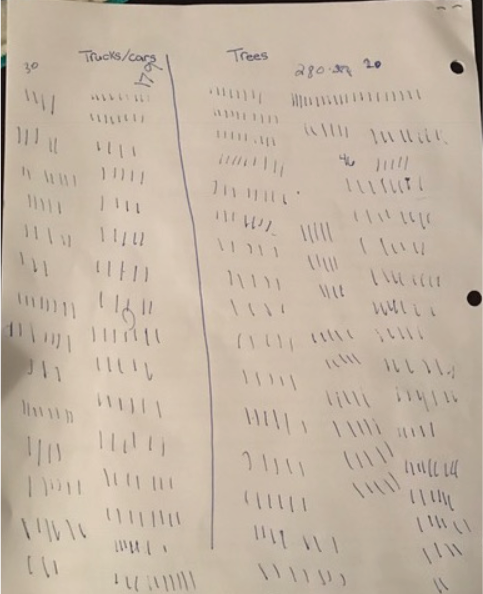
To support families, programs can provide digital and nondigital resources that facilitate science activities with children at or near home. Before conducting an activity, parents can use digital resources—such as videos, games, or simulations related to activity topics—to get their children interested in a topic, or they can use them to reinforce learning after doing an activity. For example, as part of an activity about animal communication, families might choose an interactive tool such as Bird Song Hero: The Song-Learning Game for Everyone, from the Cornell Lab of Ornithology, which enables children to listen to, compare, and identify bird songs (academy.allaboutbirds.org/bird-song-hero/).
Digital devices (mobile phones, tablets) with common features such as a stopwatch, compass, and camera, can also support learning. For example, using a mobile phone’s camera or video recorder to document observations may encourage children to search and closely examine their surroundings to further develop their understandings about the natural world or scientific phenomena. The app we developed as part of the toolkit includes various “missions” that prompt families to search for common features of urban environments (leaves, squirrels, pigeons) and record how many they find, earning them digital badges.
Nondigital resources, too, support at-home teaching and learning in several ways. For example, tools such as fact cards or FAQs (frequently asked questions) can provide parents with background information on a topic that they can use to prepare for or as part of an activity. With a notebook and crayons or colored pencils, children can create detailed drawings and comparisons (like naturalists do) or record questions to research on a trip to the library.
Expensive equipment and supplies are not needed to promote outdoor science learning.
Outdoor science learning becomes feasible for educators and families when activities make use of common low- or no-cost materials that organizations, educators, and families already have. For example, children can
- Pour water from water bottles to observe and compare how it flows on permeable (grass, soil) and more solid surfaces (pavement).
- Put leaves in plastic sandwich bags to examine transpiration—water droplets that form in the bag allow children to observe how plants “sweat” when water vapor flows out through the leaves.
- Blow bubbles and follow their paths to test predictions about how city structures affect the flow of the wind.
- Have a bee race that models how bees collect pollen and pollinate flowers. A team of children (bees) race to get pollen to the flowers before a bee-eater bird (child or adult) gets them! Use small bowls filled with sticky notes as pollen and two plates as flowers.
- Model how seed pods explode to spread seeds. Wrap a deflated balloon around a toilet paper tube and fill it with birdseed to build a “seed blaster” that sends seeds flying. Pull the balloon back as far as you can, let go, and see how far the seeds travel!
- Paint with paintbrushes and water on sunny and shady sidewalks to explore evaporation and temperature differences between different surfaces.
Preparedness
Many parents and other caregivers feel they lack the science knowledge to conduct outdoor science activities with their children. Teachers might have had limited training or support for science activities and likewise feel unprepared to facilitate them.
Activities with simple step-by-step instructions showed the most promise for effective family use.
We learned the importance of detailed and well-structured activity sheets that include procedures for facilitating each activity component, especially among parents who facilitated activities with their children as part of a self-guided program. “Animals Among Us” is an example of an activity sheet designed for parents and their children. The sheet uses clear, accessible language and includes a description of learning goals (“Big Science Idea”), materials needed, and steps to prepare for and do the activity.
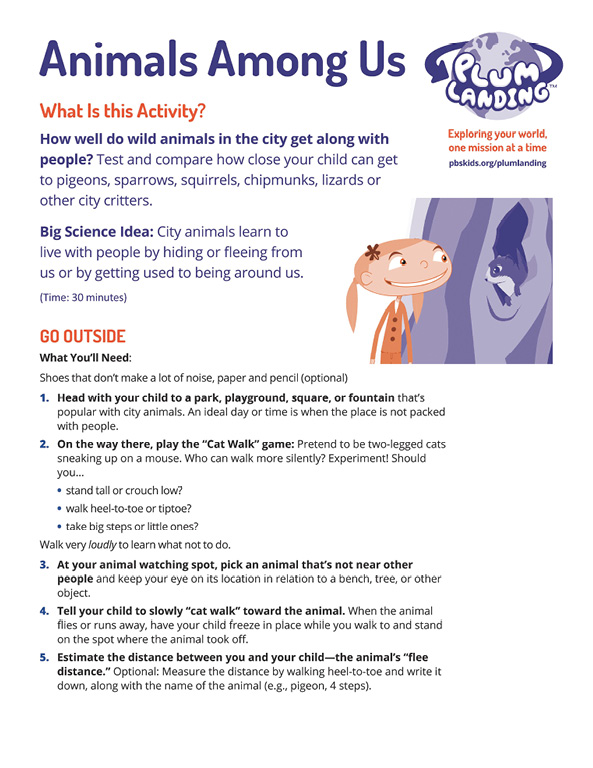
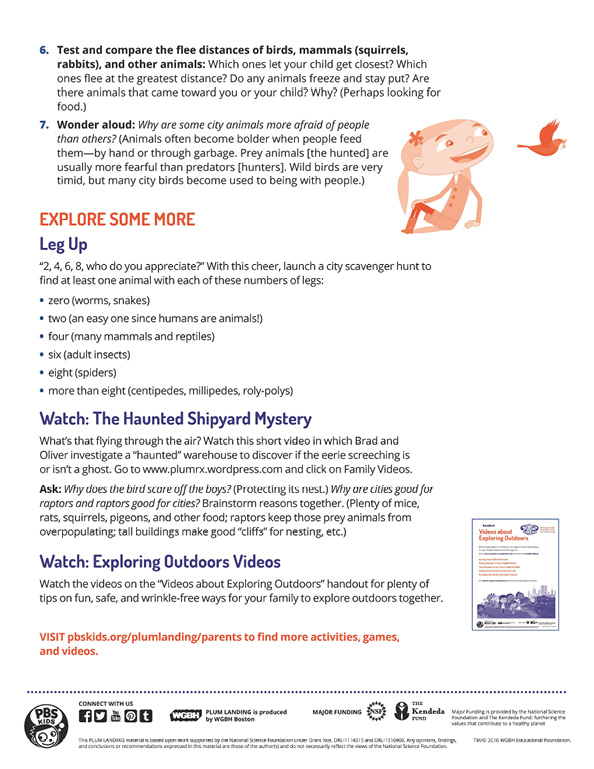
Most families in our study had little or no experience using professionally developed educational activities of this kind. The level of detail and the format of the activity sheets made the science concepts more approachable. Parents felt prepared and confident stepping into the role of educator, not like they had to follow a script; the activity sheets also did not prevent families from personalizing the activities.
Parents and educators who tested early versions of our resources suggested that the materials indicate the time typically required for each activity component and the ideal weather conditions, both of which are now specified in activity sheets. Moreover, their feedback revealed a preference for engaging children with science concepts through physically active games rather than explanation, so revised resources incorporate more movement in which children and families model focal concepts and phenomena. (The bee race warm-up activity described earlier is an example. Find activity sheets for it in English and Spanish at pbskids.org/plumlanding/educators/activities/pdf/WaggleDance_FFA_Eng_Span.pdf.)
Feedback from parents and educators also expressed the desire for supports to ensure that children connect activities back to those concepts; so revised activity sheets incorporate questions (and answers) for parents or educators to ask after activities. For example, after an activity to compare the permeability of different surfaces, questions to prompt thinking and discussion include, “What hard surfaces don’t absorb water?,” “Why can lots of rain be a problem for cities and towns?,” and “What could carry the extra water out of the city?”
Videos take pressure off educators and parents by introducing topics and piquing children’s interest in science ideas.
In our study, educators showed a short introductory video to children at the start of each facilitated activity. The purpose of the video was twofold: it provided a way to introduce the topic, and it got children excited about exploring that topic in their own neighborhoods.
For example, to kick off an activity in which children would learn that migrating animals depend on stopover sites (pockets of habitat that provide food, water, and shelter), educators began by playing a video that featured a forest ranger taking a group of children on a hike through the city to find places where animals might live. After showing the video, the educators posed a series of questions to prompt a short conversation about animals that live in their city, the animals’ local habitats, and where to and why the animals might migrate. This was a motivating segue into the next part of the activity, in which children looked for stopover sites in their immediate surroundings.
With an abundance of educational videos freely available on the internet (see “Video Resources” below), program directors at community organizations could curate a collection of educational videos for similar purposes, perhaps cataloguing videos by science topic, child age, or other factors. Providing educators and parents with easy access to such videos is a relatively low-cost initiative with high-impact potential. Additionally, because many videos present science topics in simple and engaging ways, they can reduce the amount of background research and preparation that educators or parents have to do before an activity.
Incorporating science into games makes science concepts approachable.
Our activities were designed to integrate science in a physically active, game-like way. For example, the learning goal for one activity was to teach children about the different ways in which animals move through their habitats (e.g., flying, jumping, hopping, running, slithering, waddling) as they look for food, avoid predators, and interact. The activity involved a game in which children compete to see how well their physical skills stack up against those of some of the animals in their neighborhood. The children in our pilot learned firsthand that no one can jump 20 times their body length the way a grasshopper can, or run 45 miles per hour like a coyote.
The goal of another activity was to examine how rainwater interacts with various city surfaces. It involved a Red Rover-inspired game in which children act as raindrops and try to get through a line of adults who hold hands to behave like an impermeable surface (pavement) and drop their hands to model a permeable surface (grass). The game-like approach to activities made the science concepts and vocabulary accessible, fun, and memorable; it also helped educators and families feel prepared to facilitate those activities, even if they lacked specialized science knowledge or experience.
Time and space
Families might feel they lack the time to conduct science activities and believe that urban settings are incompatible with science exploration. Many educators cannot imagine taking the time to prepare science activities. They have limited outdoor space and, like families, they see their urban settings as unconducive to science and nature activities.
Modular, flexible activities enable parents and educators to pick and choose components, based on available time.
When designing our activities, we decided to create modular components related in content and approach that could be sequenced together as a meaningful and cohesive experience or implemented as stand-alone components that would achieve the stated learning goal(s). Our activities consisted of an introductory video, a warm-up activity, one or two main activities, a wrap-up activity, and supplemental activities.
In our studies, educators and parents chose activity components based on the time they had. Even with this flexibility, they shortened or extended activities as needed. Organization directors and educators stressed the benefit of having a range of short activity components to use “on the fly” if there was extra time during a facilitated session or if a preselected activity was not going well. The table below shows the modular components of two activities.
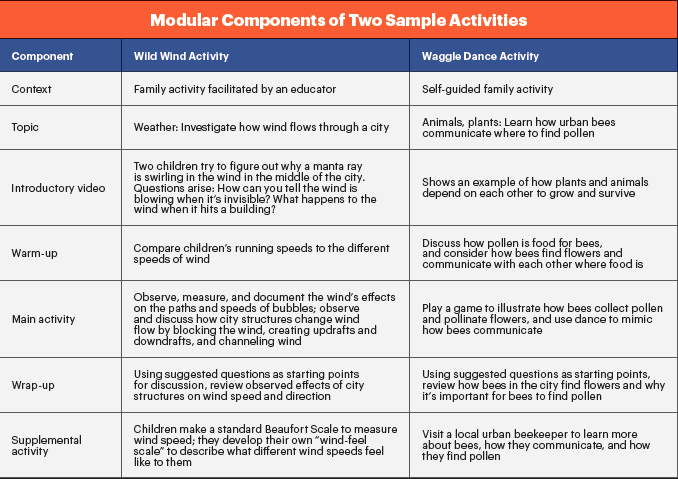
Providing activities for small urban spaces helps educators and families realize that those settings are conducive to outdoor science exploration.
Educators and families made use of sidewalks, urban parks, and local playgrounds, demonstrating that children and families can successfully explore water, wind, animals, plants, and other important science topics in urban settings. Being able to conduct outdoor science activities with little preparation, in a short period of time, and within walking distance of home was highly motivating to parents and educators. The table “Uses of Common Urban Environment Features for Science Exploration” shows common features of urban environments that educators and families can use to explore science topics.
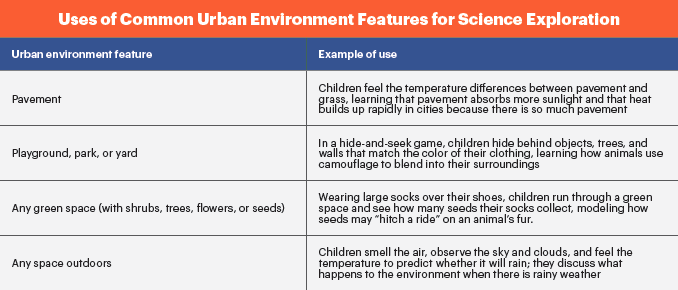
Competing priorities
Families want to spend their free time together in fun, social, and interactive activities, and science, physical fitness, and nature explorations just don’t seem to fit the bill. Educators feel pressured to focus on organizational priorities that do not include outdoor science.
Science teaching and learning can address organizations’ or families’ various priorities.
There is a range of goals that are common among community organizations and activity-seeking families, including conducting activities that are social and fun, promoting physical fitness, and engaging children in learning. In our study, physical activity was a key driver of children’s engagement with science and their overall excitement during activities; children were most engaged during rigorous physical challenges, such as mimicking animal movements, participating in time-bound scavenger hunts, and acting out predator/prey races.
In our study, physical activity was a key driver of children’s engagement with science.
Our activities were designed to be modular in ways that can give educators and families the flexibility to select activity components that most align with their own priorities, such as supporting English language learning. Using resources available in English and Spanish, an educator can strategically select activity components to optimize practicing English language skills. For example, our study included an activity in which children examine why cities are often warmer than their surrounding areas. Educators working with dual language learners could extend this activity to devote more time at the end to reviewing key vocabulary through discussions that give families meaningful opportunities to practice using the new science terms.
Rethinking what’s possible
Facilitating outdoor science exploration to achieve specific learning goals can be difficult for both new and seasoned educators, and can be daunting for parents or other caregivers. But when we take the time to develop or seek out resources that make science content more approachable, include background information that reduces educator and parent preparation time, use everyday materials, and capitalize on common features of urban neighborhoods, we make it easier for educators and parents to engage children in outdoor science learning.
Modular activities that are social, fun, and interactive, and that emphasize science, physical fitness, and nature, enable educators and families to achieve multiple priorities at the same time. Our hope is that the lessons and strategies we shared here will help educators, parents, and community organizations see their urban neighborhoods as places where they can provide children with rich and varied opportunities for science learning
Video Resources
PBS Learning Media: Educational videos, audio recordings, and professional development materials. https://whut.pbslearningmedia.org
WatchKnowLearn.org: Free K–12 educational videos organized by age and subject. www.watchknowlearn.org
References
Aaron, R.F., & P.A. Witt. 2011. “Urban Students’ Definitions and Perceptions of Nature.” Children, Youth and Environments 21 (2): 145–67.
Christiana, R.W., R.A. Battista, J.J. James, & S.M. Bergman. 2017. “Pediatrician Prescriptions for Outdoor Physical Activity Among Children: A Pilot Study.” Preventive Medicine Reports 5 (4): 100–105.
Derr, V., & K. Lance. 2012. “Biophilic Boulder: Children’s Environments That Foster Connections to Nature.” Children, Youth and Environments 22 (2): 112–43.
Flouri, E., E. Midouhas, & H. Joshi. 2014. “The Role of Urban Neighborhood Green Space in Children’s Emotional and Behavioral Resilience.” Journal of Environmental Psychology 40 (Dec.): 179–86.
Louv, R. 2008. Last Child in the Woods: Saving Our Children from Nature-Deficit Disorder. Updated & expanded ed. Chapel Hill, NC: Algonquin Books.
Razani, N., M.A. Kohn, N.M. Wells, D. Thompson, H.H. Flores, & G.W. Rutherford. 2016. “Design and Evaluation of a Park Prescription Program for Stress Reduction and Health Promotion in Low-Income Families: The Stay Healthy in Nature Everyday (SHINE) Study Protocol.” Contemporary Clinical Trials 51 (Nov.): 8–14.
Photographs: 1, © Getty Images; 2, EDC
Marion Goldstein, EdD, is a research scientist at Education Development Center, in New York. Her work examines how technology can be strategically employed to enhance pre-K–12 teaching and learning and to strengthen STEM education for all children. [email protected]
Lisa Famularo, PhD, is a founding partner of Research Matters, a research firm based in Kennebunk, Maine. Lisa is a seasoned education researcher who has focused her work on bridging the gap between research, policy, and practice. [email protected]
Jamie Kynn, MA, MSW, is a research associate at Education Development Center. Her work examines access to education and social services for individuals across the lifespan to increase equity in STEM education programs. [email protected]